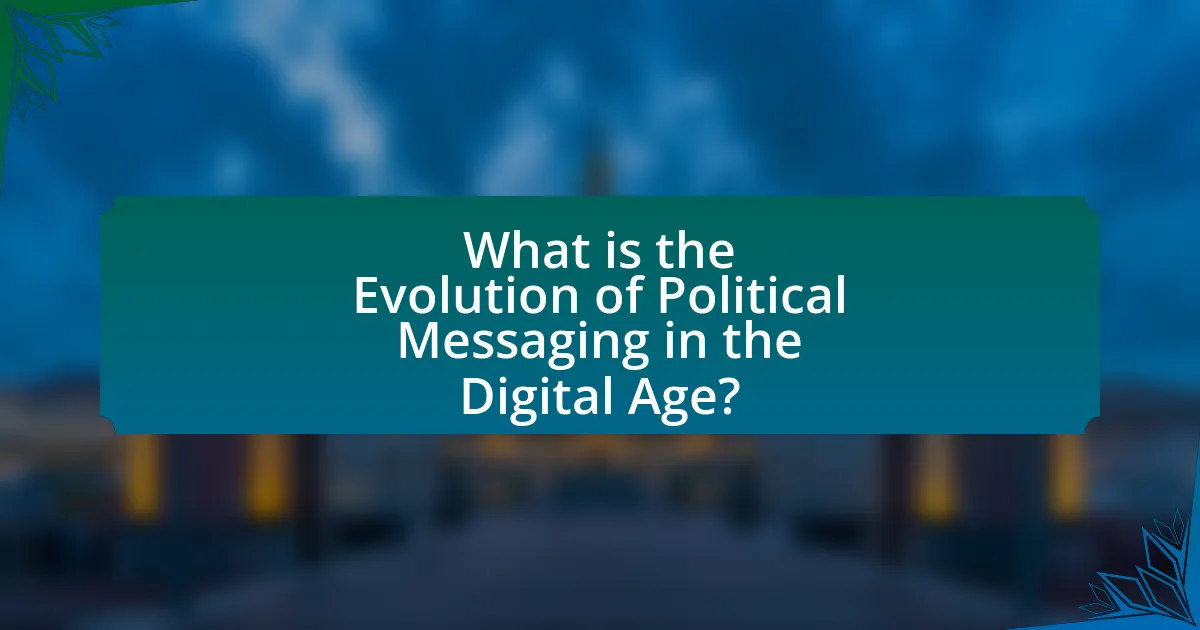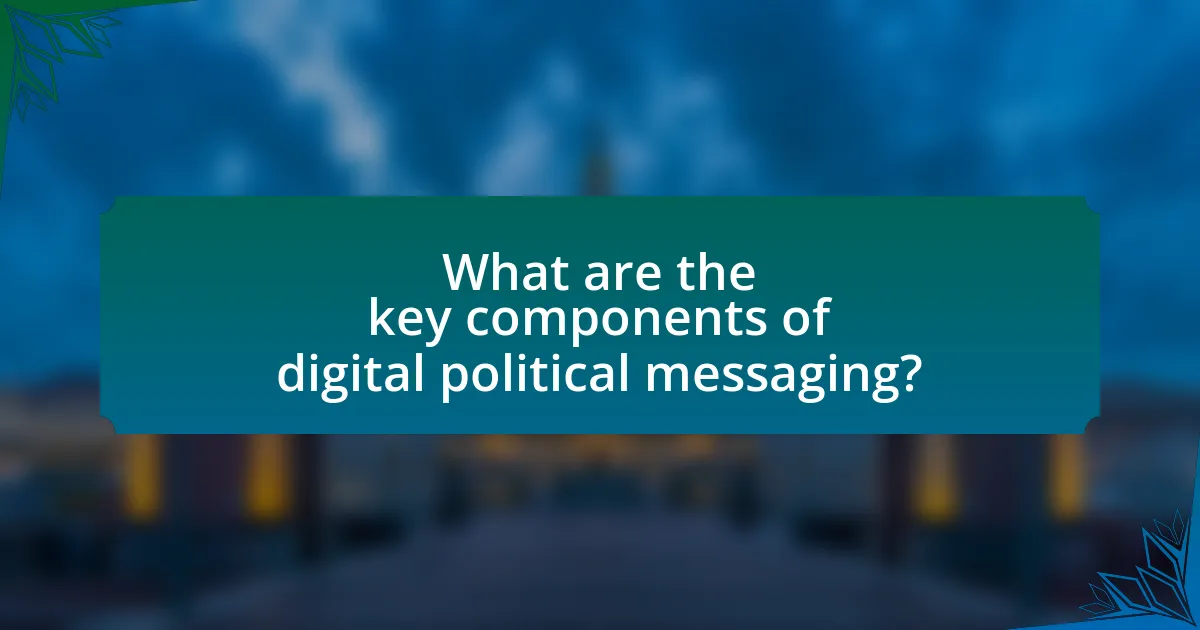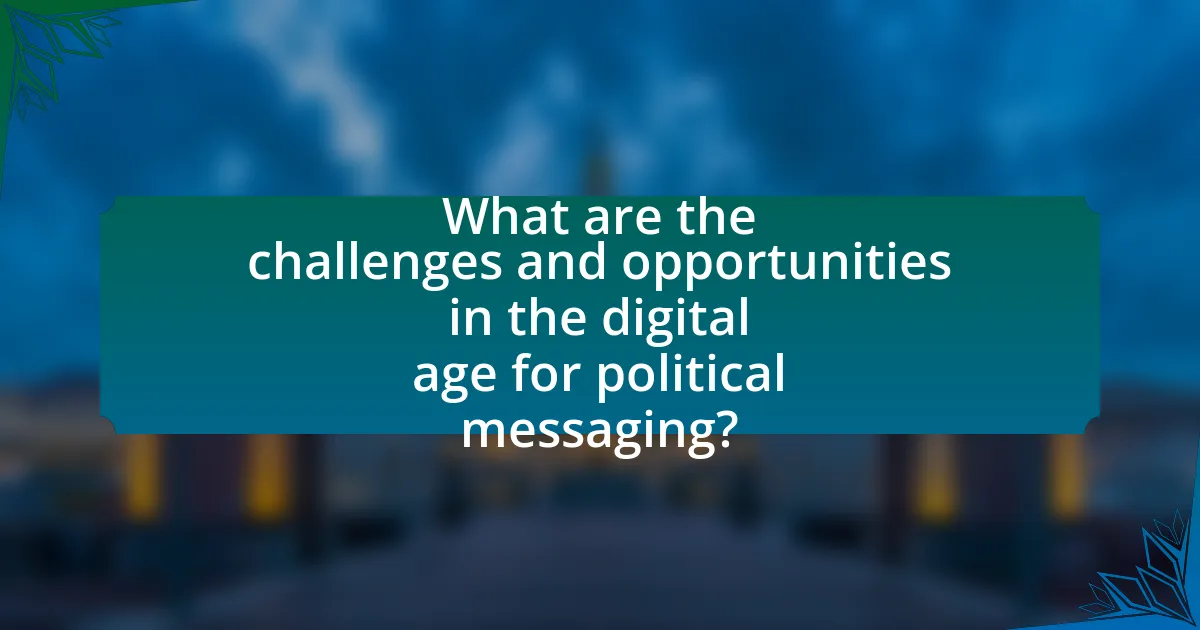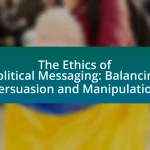The article examines the evolution of political messaging in the digital age, highlighting the transition from traditional media to digital platforms, particularly social media. It discusses key milestones in this evolution, including the impact of data analytics and targeted messaging strategies that allow for personalized communication with voters. The article also addresses the challenges posed by misinformation and echo chambers, as well as the opportunities presented by direct engagement and user-generated content. Additionally, it outlines best practices for political campaigns in leveraging digital tools to enhance voter outreach and engagement.

What is the Evolution of Political Messaging in the Digital Age?
The evolution of political messaging in the digital age has transformed how politicians communicate with the public, primarily through the rise of social media and digital platforms. Initially, political messaging relied heavily on traditional media such as television, radio, and print, where messages were crafted for mass audiences with limited interaction. However, the advent of the internet and social media platforms like Facebook, Twitter, and Instagram has enabled direct communication between politicians and constituents, allowing for real-time engagement and feedback.
This shift has led to more personalized and targeted messaging strategies, where data analytics and algorithms are used to tailor content to specific demographics. For instance, during the 2008 U.S. presidential election, Barack Obama’s campaign effectively utilized social media to mobilize younger voters, demonstrating the power of digital platforms in shaping political discourse. Additionally, the use of micro-targeting has become prevalent, with campaigns analyzing voter data to deliver customized messages that resonate with individual concerns and interests.
The digital age has also introduced challenges, such as the spread of misinformation and the impact of echo chambers, where individuals are exposed primarily to viewpoints that reinforce their own beliefs. This phenomenon has significant implications for public opinion and democratic processes, as seen in events like the 2016 U.S. presidential election, where misinformation campaigns on social media influenced voter perceptions.
Overall, the evolution of political messaging in the digital age reflects a shift towards more interactive, data-driven, and personalized communication strategies, fundamentally altering the landscape of political engagement.
How has political messaging changed with the advent of digital technology?
Political messaging has transformed significantly with the advent of digital technology, shifting from traditional media to online platforms. This change has enabled politicians to engage directly with voters through social media, allowing for real-time communication and targeted messaging. For instance, during the 2008 U.S. presidential election, Barack Obama’s campaign effectively utilized platforms like Facebook and Twitter to mobilize supporters and disseminate information rapidly, demonstrating the power of digital outreach. Additionally, data analytics has allowed campaigns to tailor messages to specific demographics, enhancing the effectiveness of political communication. This evolution reflects a broader trend where digital technology facilitates more personalized and immediate interactions between political figures and the electorate.
What are the key milestones in the evolution of political messaging?
The key milestones in the evolution of political messaging include the advent of the printing press in the 15th century, which enabled the mass distribution of pamphlets and newspapers, significantly shaping public opinion. The introduction of radio in the early 20th century allowed politicians to reach wider audiences through broadcasts, exemplified by Franklin D. Roosevelt’s Fireside Chats. The emergence of television in the 1950s transformed political campaigns, with visual imagery becoming crucial, as seen in John F. Kennedy’s televised debates against Richard Nixon in 1960. The rise of the internet in the late 20th century revolutionized political messaging, facilitating direct communication between politicians and voters through websites and email. Finally, the advent of social media in the 21st century has further transformed political messaging, enabling real-time engagement and targeted advertising, as evidenced by Barack Obama’s 2008 campaign, which effectively utilized platforms like Facebook and Twitter to mobilize supporters.
How have social media platforms influenced political communication?
Social media platforms have significantly transformed political communication by enabling direct interaction between politicians and the public. This shift allows for real-time engagement, where candidates can share their messages instantly and respond to constituents’ concerns without traditional media filters. For instance, during the 2008 U.S. presidential election, Barack Obama’s campaign effectively utilized platforms like Facebook and Twitter to mobilize supporters and disseminate information, leading to increased voter engagement and turnout. Additionally, studies indicate that social media can amplify political polarization, as users often engage with content that aligns with their beliefs, reinforcing existing opinions. This dual impact of facilitating communication while also contributing to division illustrates the profound influence of social media on the political landscape.
Why is understanding the evolution of political messaging important?
Understanding the evolution of political messaging is important because it reveals how communication strategies adapt to societal changes and technological advancements. Political messaging has transformed significantly from traditional media to digital platforms, influencing public opinion and voter behavior. For instance, the rise of social media has enabled targeted messaging, allowing campaigns to reach specific demographics more effectively, as seen in the 2008 Obama campaign which utilized platforms like Facebook and Twitter to engage younger voters. This evolution highlights the necessity for political entities to adapt their strategies to remain relevant and effective in influencing the electorate.
What impact does political messaging have on public opinion?
Political messaging significantly shapes public opinion by influencing perceptions, attitudes, and behaviors regarding political issues and candidates. Research indicates that targeted political messages, especially through social media platforms, can sway voter preferences and increase political engagement. For instance, a study by the Pew Research Center found that 62% of adults in the U.S. get news from social media, highlighting its role in shaping public discourse. Additionally, political campaigns that utilize emotional appeals in their messaging have been shown to enhance voter mobilization, as evidenced by the success of emotionally charged advertisements in recent elections.
How does political messaging shape electoral outcomes?
Political messaging significantly shapes electoral outcomes by influencing voter perceptions and behaviors. Effective political messaging can create emotional connections, frame issues in a favorable light, and mobilize specific demographics. For instance, during the 2008 U.S. presidential election, Barack Obama’s campaign utilized targeted messaging through social media platforms, which helped him engage younger voters and increase turnout, ultimately leading to his victory. Research indicates that campaigns that adapt their messaging to resonate with the values and concerns of their target audience are more likely to succeed, as evidenced by the strategic use of data analytics in modern political campaigns.

What are the key components of digital political messaging?
The key components of digital political messaging include targeted audience segmentation, engaging content creation, strategic platform selection, data analytics, and real-time feedback mechanisms. Targeted audience segmentation allows political campaigns to tailor messages to specific demographics, enhancing relevance and impact. Engaging content creation, such as videos, infographics, and interactive posts, captures attention and encourages sharing. Strategic platform selection ensures that messages reach the intended audience through channels like social media, email, and websites. Data analytics provide insights into audience behavior and preferences, enabling campaigns to refine their strategies. Real-time feedback mechanisms, such as comments and shares, allow for immediate interaction and adjustment of messaging based on audience response. These components collectively enhance the effectiveness of political messaging in the digital landscape.
How do different digital platforms affect political messaging strategies?
Different digital platforms significantly influence political messaging strategies by shaping how messages are crafted, disseminated, and received. Social media platforms like Facebook and Twitter allow for rapid dissemination of information and direct engagement with voters, enabling campaigns to tailor messages to specific demographics based on user data. For instance, the 2016 U.S. presidential election showcased how targeted ads on Facebook reached specific voter segments, enhancing message relevance and impact. In contrast, platforms like YouTube facilitate longer-form content, allowing for in-depth storytelling that can resonate emotionally with viewers. Research indicates that visual content on platforms like Instagram can increase engagement rates, making it a powerful tool for political campaigns aiming to connect with younger audiences. Thus, the choice of platform directly affects the strategy, tone, and effectiveness of political messaging.
What role do algorithms play in shaping political content visibility?
Algorithms significantly influence political content visibility by determining which information is prioritized and presented to users on digital platforms. These algorithms analyze user behavior, preferences, and engagement metrics to curate content that aligns with individual interests, often amplifying politically charged messages that resonate with users. For instance, research by the Pew Research Center indicates that social media algorithms can create echo chambers, where users are predominantly exposed to viewpoints that reinforce their existing beliefs, thereby shaping public discourse and political polarization. This selective visibility can impact voter behavior and public opinion, as users may become more entrenched in their political views due to the tailored content they encounter.
How do demographics influence messaging on various platforms?
Demographics significantly influence messaging on various platforms by shaping the content, tone, and delivery methods used to engage specific audience segments. For instance, younger demographics tend to favor platforms like TikTok and Instagram, where messaging is often visual and informal, while older demographics may prefer Facebook or email, where messaging can be more detailed and formal. Research indicates that 60% of Gen Z users engage with brands through short video content, highlighting the need for concise and engaging messaging tailored to their preferences. Additionally, cultural background, education level, and geographic location further dictate how messages are crafted and received, ensuring that political messaging resonates effectively with diverse audience groups.
What techniques are commonly used in digital political messaging?
Common techniques used in digital political messaging include targeted advertising, social media engagement, data analytics, and content marketing. Targeted advertising allows campaigns to reach specific demographics based on user data, enhancing message relevance and effectiveness. Social media engagement fosters direct interaction with voters, enabling real-time feedback and community building. Data analytics helps campaigns understand voter behavior and preferences, allowing for tailored messaging strategies. Content marketing, through blogs, videos, and infographics, disseminates information in an engaging manner, increasing shareability and reach. These techniques have been validated by numerous political campaigns, such as Barack Obama’s 2008 campaign, which effectively utilized social media and data analytics to mobilize voters.
How do campaigns utilize data analytics for targeted messaging?
Campaigns utilize data analytics for targeted messaging by analyzing voter demographics, preferences, and behaviors to tailor their communication strategies. This approach allows campaigns to segment their audience effectively, ensuring that messages resonate with specific groups based on data-driven insights. For instance, a study by the Pew Research Center found that targeted messaging can increase engagement rates by up to 50%, demonstrating the effectiveness of personalized communication in political campaigns. By leveraging data analytics, campaigns can optimize their outreach efforts, allocate resources efficiently, and ultimately enhance voter mobilization.
What are the ethical considerations in digital political messaging?
Ethical considerations in digital political messaging include transparency, misinformation, privacy, and manipulation. Transparency requires that political messages clearly disclose their sources and funding, as seen in regulations like the Federal Election Commission’s rules on campaign advertising. Misinformation poses a significant risk, as false narratives can spread rapidly online, impacting public opinion and electoral outcomes; for instance, studies have shown that false information is 70% more likely to be retweeted than true information. Privacy concerns arise from the collection and use of personal data for targeted messaging, which can infringe on individual rights and autonomy. Lastly, manipulation through emotional appeals or algorithmic targeting raises questions about the integrity of democratic processes, as evidenced by the Cambridge Analytica scandal, where data was used to influence voter behavior without consent. These considerations highlight the need for ethical standards in the evolving landscape of digital political communication.

What are the challenges and opportunities in the digital age for political messaging?
The challenges in the digital age for political messaging include misinformation, information overload, and the rapid spread of content, which can distort public perception and hinder effective communication. For instance, a study by the Pew Research Center found that 64% of Americans believe that fabricated news stories cause confusion about the basic facts of current events. Conversely, opportunities in this era involve targeted messaging through data analytics, increased engagement via social media platforms, and the ability to reach diverse audiences instantly. According to a report by the Digital Marketing Institute, 70% of marketers believe that social media is essential for political campaigns, highlighting its role in enhancing voter outreach and mobilization.
What challenges do political campaigns face in the digital landscape?
Political campaigns face several challenges in the digital landscape, including misinformation, data privacy concerns, and the rapid pace of technological change. Misinformation can spread quickly on social media platforms, undermining the credibility of campaigns and creating confusion among voters. Data privacy concerns arise as campaigns collect and utilize personal information for targeted advertising, leading to potential backlash from the public and regulatory scrutiny. Additionally, the rapid evolution of technology requires campaigns to continuously adapt their strategies, which can strain resources and expertise. These challenges necessitate a proactive approach to digital engagement and communication strategies to effectively reach and influence voters.
How do misinformation and fake news impact political messaging?
Misinformation and fake news significantly distort political messaging by shaping public perception and influencing voter behavior. These false narratives can create confusion, erode trust in legitimate sources, and polarize opinions, ultimately affecting electoral outcomes. For instance, a study by the Pew Research Center found that 64% of Americans believe that fabricated news stories cause a great deal of confusion about the basic facts of current events. This manipulation of information can lead to misinformed voters making decisions based on inaccurate representations of candidates and policies, thereby undermining the democratic process.
What strategies can campaigns employ to combat misinformation?
Campaigns can employ fact-checking, media literacy initiatives, and transparent communication to combat misinformation. Fact-checking involves verifying claims made in political messaging and publicly correcting false information, which has been shown to reduce the spread of misinformation by up to 70% in some studies. Media literacy initiatives educate the public on identifying credible sources and understanding the context of information, thereby empowering individuals to critically evaluate content. Transparent communication, where campaigns openly share their sources and methodologies, fosters trust and encourages informed discussions among constituents. These strategies collectively enhance the integrity of political messaging in the digital age.
What opportunities does the digital age present for political messaging?
The digital age presents significant opportunities for political messaging by enabling direct communication between politicians and the electorate. This direct engagement allows for real-time feedback and interaction, fostering a more dynamic relationship. For instance, social media platforms like Twitter and Facebook have been utilized by political figures to disseminate messages instantly, reaching millions of users without traditional media gatekeeping. According to a Pew Research Center study, 69% of adults in the U.S. use social media, highlighting its potential as a powerful tool for political outreach. Additionally, data analytics allows campaigns to target specific demographics with tailored messages, increasing the effectiveness of political communication. This targeted approach is supported by research from the Harvard Kennedy School, which found that personalized messaging can significantly enhance voter engagement and turnout.
How can campaigns leverage user-generated content for engagement?
Campaigns can leverage user-generated content for engagement by encouraging supporters to create and share their own content related to the campaign. This approach fosters a sense of community and authenticity, as individuals are more likely to trust content created by their peers rather than traditional advertisements. For instance, a study by the Nielsen Company found that 92% of consumers trust recommendations from friends and family over any other form of advertising. By utilizing platforms like social media, campaigns can amplify this user-generated content, increasing visibility and engagement through shares, likes, and comments. This strategy not only enhances the campaign’s reach but also cultivates a more interactive and participatory environment for supporters.
What innovative approaches are being used in digital political campaigns?
Innovative approaches in digital political campaigns include the use of data analytics, social media targeting, and interactive content. Data analytics allows campaigns to segment voters based on behavior and preferences, enabling tailored messaging that resonates with specific demographics. Social media targeting leverages platforms like Facebook and Twitter to reach potential voters with precision, utilizing algorithms to deliver ads to users most likely to engage. Interactive content, such as quizzes and polls, fosters engagement and encourages voter participation, enhancing the overall campaign experience. These methods have been shown to increase voter turnout and engagement, as evidenced by the 2020 U.S. presidential election, where targeted digital strategies played a crucial role in mobilizing younger voters.
What best practices should political campaigns follow in digital messaging?
Political campaigns should prioritize authenticity, audience targeting, and engagement in digital messaging. Authenticity builds trust, as voters are more likely to connect with genuine voices rather than scripted messages. Audience targeting is crucial; campaigns must utilize data analytics to identify and reach specific demographics effectively, ensuring that messages resonate with the intended audience. Engagement is essential; campaigns should encourage interaction through social media platforms, responding to comments and fostering discussions to create a sense of community. According to a study by the Pew Research Center, 69% of adults in the U.S. use social media, highlighting the importance of these platforms for reaching voters.
How can campaigns effectively measure the success of their messaging strategies?
Campaigns can effectively measure the success of their messaging strategies by utilizing key performance indicators (KPIs) such as engagement rates, conversion rates, and audience reach. Engagement rates, which include likes, shares, and comments on social media platforms, provide direct feedback on how well the messaging resonates with the target audience. Conversion rates, measured by the number of individuals taking a desired action (such as signing up for a newsletter or donating), indicate the effectiveness of the messaging in prompting action. Audience reach, which tracks the number of unique users exposed to the campaign, helps assess the overall visibility and penetration of the messaging. According to a study by the Pew Research Center, campaigns that analyze these metrics can adjust their strategies in real-time, leading to a 30% increase in overall effectiveness.
What are the key elements of a successful digital political campaign?
The key elements of a successful digital political campaign include a strong online presence, targeted messaging, data analytics, social media engagement, and effective fundraising strategies. A strong online presence ensures visibility across various platforms, while targeted messaging resonates with specific voter demographics, increasing engagement. Data analytics allows campaigns to track voter behavior and preferences, enabling tailored outreach. Social media engagement fosters direct communication with constituents, enhancing relatability and trust. Effective fundraising strategies leverage digital tools to mobilize resources quickly, as evidenced by the 2020 U.S. presidential campaigns, where digital fundraising played a crucial role in campaign financing.


